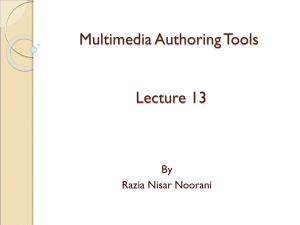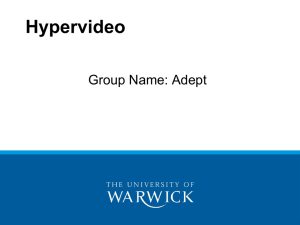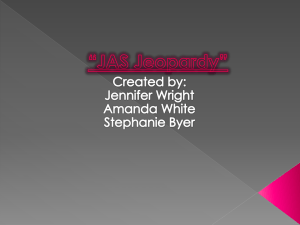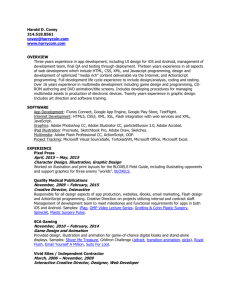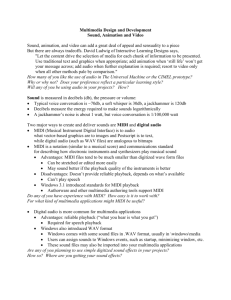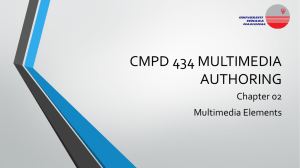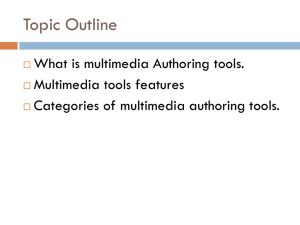Chapter 8
advertisement
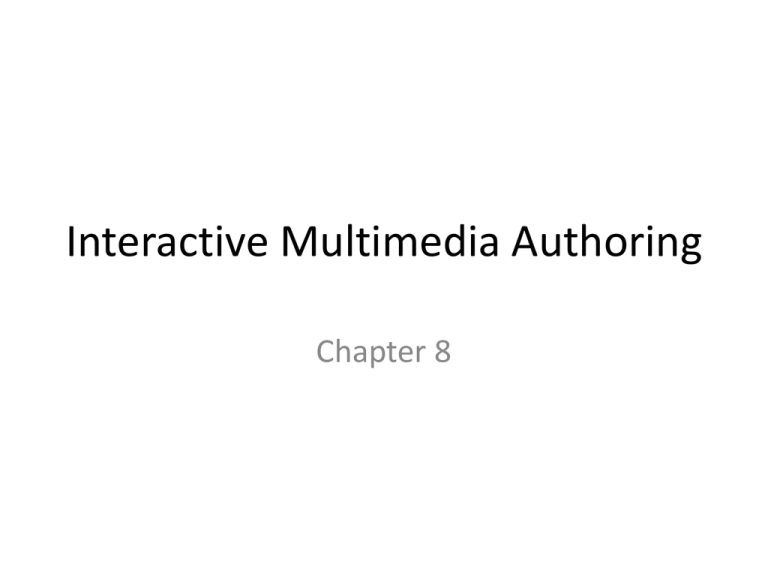
Interactive Multimedia Authoring Chapter 8 What is Multimedia Authoring? • Process of creating a multimedia production • Assembling or sequencing different media elements • Adding interactivity • Packaging the production for distribution to the end users. Easy to miss… • In authoring and producing your Lego animation, it is easy to forget: You are authoring a multimedia production • While I want the final product to be good, It’s the process that matters most. The process is valuable learning EXAMPLE • Task: You want to place the Lego figure on a background image • Problem: The magic wand tool can’t crop the Lego figures in your photographs from the white background • Solutions: – Crop the figures manually – Re-photograph figures on a background with more color contrast. • Lesson Learned: Test the process before photographing 100+ images. Mistakes are learning opportunities • The team that makes the most mistakes learns the most. • A team that’s very lucky can miss the big picture: Example: • We are not just photographing figures • We are photographing figures that can be extracted from the background and then manipulated independently. Process vs. Product: Another Example • Team decides to film video at full HD (1920 X 1080 X 60 fps) • 13GB video file is too big to import into Flash, iMovie, etc. (exceeds the systems available memory) • From a production point of view, this is a failure • From a process point of view, you just learned how HD video creates challenges for editors and producers of multimedia. Other kinds of Multimedia Production Obviously, there is more than just Lego animation. • • • • • • Business Presentations Trade-show or Conference Demonstrations Museum Exibits Advertising Kiosks Educational Products (tutorials, demos, etc.) Games Terminology: Media vs. Medium • If I asked you about your project: • What media are you using? How would you answer? • What medium are you using? How would you answer? Terminology: Media vs. Medium • Q: What media are you using? • A: Video, still-frame animation, audio, some text. • Q: What medium are you using? • A: Internet Medium (the term) Medium: channel of general communication. Could pertain to the means of communication – TV – Internet – Radio, etc. Could also pertain to the inherent content, but only if it is assumed to be one type of content – Video – Text – Audio, etc. Media (the term) Media: The plural of medium Because it’s plural, it’s a better term for talking about content, which often includes more than one medium. “What media are included in your production” • Also used to personify the communication network, i.e., the television news media – refers to the collective network including the people Distribution Medium A production that includes multiple media (audio, images, text) can be tailor for one particular distribution medium • CD, DVD, BluRay • Internet (played in a web browser) • TV Broadcast • Radio Broadcast Medium Distribution Channel • Because a production (which could have multiple media) is commonly produced for one distribution medium, • The term medium is most often associated with distribution or communication network, i.e., Internet, TV, Radio, etc. Media Content Types What media are used in the production? Images and text are the media used. Medium is rarely used to refer to content types unless it is assume that there is only one type Media (collective singular) Personification of a Distribution Network The television media is obsessed with the Casey Anthony story • Here you are talking about only one communication network, i.e., TV. The news media is a joke these days. • Here you are talking about more than one network (TV New, Radio New, Newpapers, etc.), but we still refer to it a collective singular. • Analogy, one herd, one flock Interactive Multimedia Authoring Typical Communication mediums (media would be grammatically correct, but less precise) 1. Internet (web browser) 2. CD, DVD, etc. (applications – games) Media used: • Everything (text, images, audio, video). Communication Medium is important • A multimedia production can be 4GB if it is produced for DVD. • 4GB posses problems for multimedia productions mean to be delivered over the Internet. • Flash technology emerged because of this very problem. Adobe’s Flash (what is it really?) • Authoring environment where you can put together objects: images, text, audio, and video. • But, you can also change (animate) the objects in a timeline. • But, you can also add code (ActionScript) to add interactivity to the objects Three Object Classes • Graphic – Could be composed of raster images and vector shapes – Just meant to be seen – No temporal (time-based) characteristics, i.e., no time line • Movie Clip – Same as graphic but has temporal characteristics, i.e., it has an independent timeline • Button – Same as graphic but has extra interactive features – Responds to keyboard and mouse events Production Process 1. 2. 3. 4. Collect the media elements Assemble them Add interactivity Package movie for distribution to the end users Production Process (limited by Flash) 1. Collect the media elements – Limited formats • • • Images (png, gif, jpeg) Audio (wav, aiff) Video (avi, mov, mpeg) 2. Assemble them – – Limited by stage (set resolution) Limited by timeline (set frames per second) 3. Add interactivity – Limited by what ActionScript can do 4. Package movie for distribution to the end users – SWF output (mean for Internet, but can be put on DVD). Two Basic Animation Models Limitations of Tweening • Vector objects (Flash shapes) can morph • Raster graphics (bitmaps) cannot morph – They can only • Change position • Change scaling (size) • “morph” – Circle to square – Change sub-parts • Move just the arm • Rotate just the head Scripted Animation vs. … • Frame-by-frame animation requires editing individual frames • Tweened animation requires editing key frames (the in-between frames are generated automatically) • Script Animation uses the power of code – Translation functions – Change objects mathematically Flash Concept: The Stage (0,0) (x,y) Authoring: Script vs. Stage • Flash offers a stage where you can manually place and edit objects. • ActionScript also lets you place objects on the stage, but it gives you more automated control. • Place object at exact X, Y coordinate – X and Y can come from a function – Move (translate objects based on function, rather than manual editing). Chapter 8: Flash Terminology • Flash isn’t going away. • In fact, new program mimic Flash’s environment • Chapter 8 is a good read… • Introduces a lot of terminology – Shape, Fill, Stroke – Merge mode – overlapping objects are merged in on object Script vs. Stage • The best option is to combine manual Stage authoring and ActionScript code. • ActionScript helps you reuse your manual work. • Example: – Animating a crowd – Use the stage to draw/import a graphic (person) – Use ActionScript to manipulate multiple instances of the graphic (animate a dozen people with one function)
